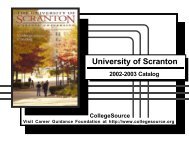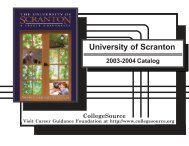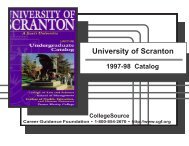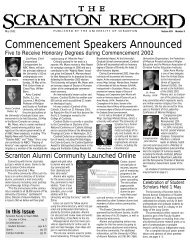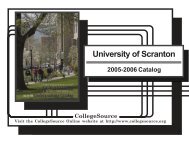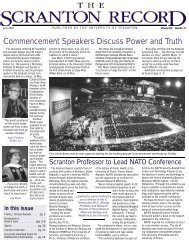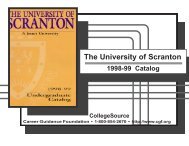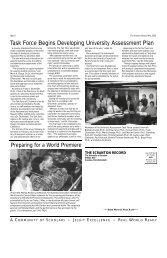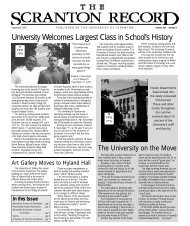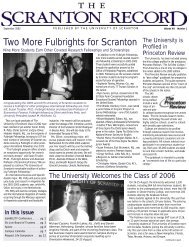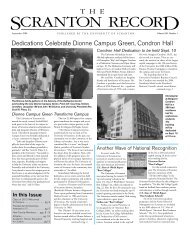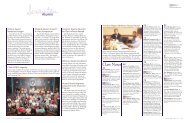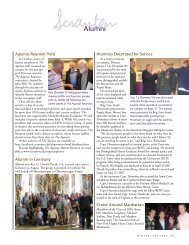1999-2000 - The University of Scranton
1999-2000 - The University of Scranton
1999-2000 - The University of Scranton
You also want an ePaper? Increase the reach of your titles
YUMPU automatically turns print PDFs into web optimized ePapers that Google loves.
ARTH 117 Dr. Dunn<br />
(W)Early Christian and 3 credits<br />
Byzantine Art<br />
(Formerly ARTH 203) <strong>The</strong> art and architecture<br />
produced by the first Christians<br />
borrowed much from the forms and ideas<br />
<strong>of</strong> Roman art. <strong>The</strong> course surveys art produced<br />
in Rome, Ravenna, Milan, Greece<br />
and Constantinople, 200-1400 A.D.<br />
Emphasis will be placed on the origin and<br />
symbolism <strong>of</strong> Christian imagery and<br />
architecture.<br />
ARTH 118 Dr. Dunn<br />
(W)Medieval Art: 3 credits<br />
Romanesque and Gothic<br />
(Formerly ARTH 204) A survey <strong>of</strong> art and<br />
architecture in western Europe, 1100-<br />
1400. Medieval architecture, manuscripts,<br />
paintings, and decorative arts will be presented<br />
as mirrors <strong>of</strong> medieval thought and<br />
spirituality.<br />
ARTH 205 Dr. Dunn<br />
<strong>The</strong> Icon in Russian and 3 credits<br />
East European Art<br />
This course focuses on theology, image<br />
and artistic style in the making <strong>of</strong> the icon<br />
in Russia and East Europe. <strong>The</strong> icon will<br />
be studied in its historical and cultural<br />
context from medieval through modern<br />
times.<br />
ARTH 210 Staff<br />
(C,D)Topics on Women in 3 credits<br />
the Visual Arts<br />
This cross-disciplinary course presents<br />
selected topics on women in the visual<br />
arts, including the history <strong>of</strong> women’s<br />
achievements and struggles in the visual<br />
arts, varied ways <strong>of</strong> thinking and writing<br />
about women, art and culture. Topics will<br />
include, but are not limited to: Survey <strong>of</strong><br />
Women in Art; Being Female in the<br />
Renaissance, Medieval Women in Image<br />
and Text; Contemporary Women Artists;<br />
<strong>The</strong> Female Artist in Latin America;<br />
Women Artists in America; 19th-Century<br />
Women Artists, etc.<br />
78<br />
ARTH 213 Dr. Miller-Lanning<br />
(C)American Art 3 credits<br />
A survey <strong>of</strong> American architecture, painting<br />
and sculpture from the earliest exploration<br />
days. <strong>The</strong> course will cover art <strong>of</strong><br />
Native America, the colonial period, the<br />
Civil War era, and the twentieth-century.<br />
ARTH 214 Dr. Dunn<br />
(C)Renaissance Art and 3 credits<br />
Architecture: 1250-1500<br />
(Formerly ARTH 310) A survey <strong>of</strong> the art<br />
produced in Italy, 1250-1500, the course<br />
opens with Cimabue in Assisi <strong>of</strong> St.<br />
Francis, continues into the fourteenth century<br />
with the frescoes <strong>of</strong> Giotto and<br />
Duccio, and concludes with such fifteenthcentury<br />
artists as Brunelleschi, Donatello,<br />
Botticelli, Leonardo da Vinci, and the<br />
young Michelangelo.<br />
ARTH 215 Dr. Dunn<br />
<strong>The</strong> Renaissance 3 credits<br />
in Northern Europe<br />
(Formerly ARTH 311) Art produced in<br />
northern Europe (France, Germany,<br />
Belgium, and the Netherlands) differs<br />
remarkably from the art produced in Italy<br />
by Botticelli and Michelangelo. This<br />
course surveys painting north <strong>of</strong> the Alps<br />
by such artists as Jan van Eyck, Rogier<br />
van der Weyden, Hieronymus Bosch, and<br />
Albrecht Dürer.<br />
ARTH 216 Dr. Dunn<br />
(C,W)Michelangelo and 3 credits<br />
His World<br />
(Formerly ARTH 410) This course investigates<br />
the painting, sculpture, and architecture<br />
<strong>of</strong> Michelangelo. By considering<br />
the artistic traditions to which he fell heir<br />
as a Florentine artist, the traditional and<br />
the innovative aspects <strong>of</strong> Michelangelo’s<br />
work will be assessed. Readings from his<br />
letters and poetry, and from sixteenth-century<br />
biographies will furnish a rich context<br />
for the appreciation <strong>of</strong> his work and for<br />
understanding the society to which he<br />
belonged.



